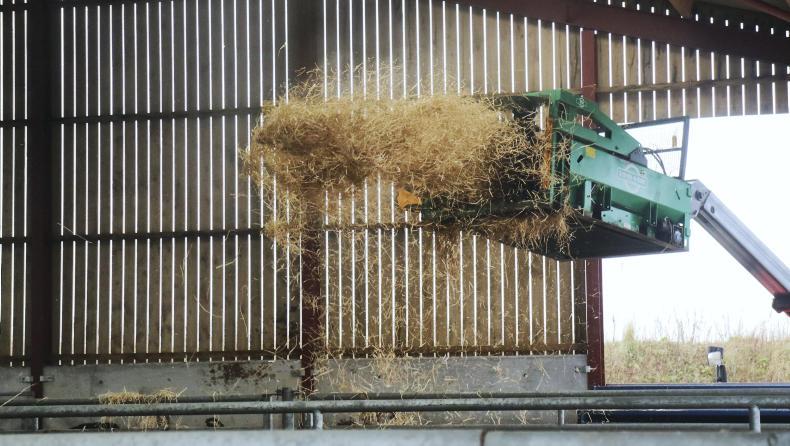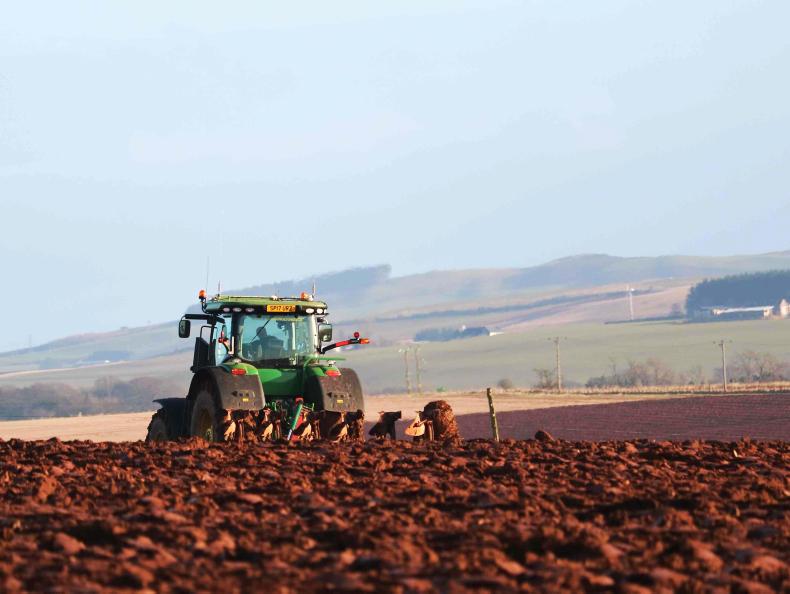Andrew Gammie has been farming in a family partnership based at Drumforber Farm, Laurencekirk, since 2015. It is a 131ha mixed farming unit with barley for malting and oats for milling taking up most of the arable area along with an annual potato let.
The grassland on the farm currently supports a mixed herd of pedigree and commercial cows.

Andrew Gammie runs an arable and cattle farm 30 miles south of Aberdeen.
A small number of bulls are sold as pedigrees and the remainder are sold store at around eight to 10 months, after weaning. Prior to the project, the business was calving over an extended period. This has since been reduced to two distinct spring and autumn blocks.
Until 2019, most heifers were retained to grow the breeding herd, meaning that output from the herd has been quite low. However, with the herd approaching the level that Andrew feels is sustainable into the future, there will now be heifer sales.
Prior to the project, the business made significant investments in renewable projects, with both biomass and solar energy being used.
Changes on farm: GrasslandGrazing management
Through changing the grazing management, Andrew has increased the stocking density and land utilisation at Drumforber. The cattle are now grazed in rotations, giving the grass the opportunity to rest and produce a greater overall yield. This has allowed the increase in the stocking rate from an already high 2.52 LU/ha to 2.98 LU/ha.
Fertiliser use
The change in grazing regime has also led to a change in fertiliser policy. Before joining the project, the business would apply fertiliser in larger doses to last over a longer spell through the season, leading to the purchase of around 34t of fertiliser for the grazing ground every year.

Andrew extends his season by putting cattle onto stubble parks at the end of summer.
Andrew now applies fertiliser in smaller doses to match grass need, grass growth and the stage of the season. This means that 2019 saw the purchase of just over 28t of fertiliser, nearly 6t less than previously. Not only is this financially better for the business, it is also far better for the environment.
Grazing season length
Prior to the project, cattle at Drumforber would be turned out of the sheds to graze in May and housed again in October, giving a five-month grazing season. In 2017, the first cattle were turned out in early March, with nearly all being out by April and not housed until November. With further improvements, over the life of the project, the farm now has an eight-and-a-half-month grazing season. Again, this is financially better for the business with the winter costing 85p/animal/day and grazing costing 43p/animal/day.
Changes on farm: home-grown feedSilage quality
Since joining the programme, the Gammies have changed the way that they make silage. Previously, the farm would make one cut of a bulky feed to match the cows’ need over winter. This meant that the youngstock would need 2kg to 3kg per animal of concentrates per day through the winter.

Andrew uses a loader mounted straw blower to bed his cattle.
Now they make two to three cuts of higher-quality silage to match the requirements of the youngstock and feed the cows differently. This has led to a reduction in purchased feeds for wintering youngstock to 1kg per animal per day. Again, this is not only better financially for the business, it is also more environmentally sound as the higher-quality feed releases less methane on digestion.

Andrew's farm is on good land and can grow a range of crops including barley, oats and potatos.
Arable contribution
The business has also introduced red clover into the greening fallow. This gives a number of advantages:
Green cover on the fallow ground.A cut of high-protein silage is available after the fallow period.Grazing for lambs over winter.The arable part of the business also contributes straw for cow diets in the winter and from 2020 will also have forage crops to carry sheep.
Once the red clover was established, there was a significant amount of grass available on the farm over winter. To make the best use of this, the business rented winter grazing to a neighbour with lambs last year. With the improvement that the sheep grazing brought to the grass swards, Andrew decided to establish a full-time sheep flock on the farm. This has led to a partnership with a friend in a 30-ewe pedigree Texel flock.
What does this mean for the bottom line?Due to fact that this was effectively a new business at the start of the project, there was not much of a baseline to work from. Also, the pedigree sales and costs skew the results quite badly. Instead, we have taken the pedigrees out and used the other farms as a comparison for the data at Drumforber.

Andrew produces pedigree Limousin bulls.
In the 2019 benchmark year, Andrew sold the bull calves as weaned stores, directly off their mothers. Some heifers were retained, with the balance going off store. Average calf value was £855. With a weaning rate of 95%, this translates to an output per cow of £839.
As the bull calves were not carried for the winter and the heifers were grown on a simple silage diet, feed costs were low. Total variable costs amounted to £518. This left a gross margin per cow of £353.
As previously mentioned, the stocking rate at Drumforber is nearly 3LU/ha, meaning that the gross margin per hectare is £761.
Andrew Gammie has been farming in a family partnership based at Drumforber Farm, Laurencekirk, since 2015. It is a 131ha mixed farming unit with barley for malting and oats for milling taking up most of the arable area along with an annual potato let.
The grassland on the farm currently supports a mixed herd of pedigree and commercial cows.

Andrew Gammie runs an arable and cattle farm 30 miles south of Aberdeen.
A small number of bulls are sold as pedigrees and the remainder are sold store at around eight to 10 months, after weaning. Prior to the project, the business was calving over an extended period. This has since been reduced to two distinct spring and autumn blocks.
Until 2019, most heifers were retained to grow the breeding herd, meaning that output from the herd has been quite low. However, with the herd approaching the level that Andrew feels is sustainable into the future, there will now be heifer sales.
Prior to the project, the business made significant investments in renewable projects, with both biomass and solar energy being used.
Changes on farm: GrasslandGrazing management
Through changing the grazing management, Andrew has increased the stocking density and land utilisation at Drumforber. The cattle are now grazed in rotations, giving the grass the opportunity to rest and produce a greater overall yield. This has allowed the increase in the stocking rate from an already high 2.52 LU/ha to 2.98 LU/ha.
Fertiliser use
The change in grazing regime has also led to a change in fertiliser policy. Before joining the project, the business would apply fertiliser in larger doses to last over a longer spell through the season, leading to the purchase of around 34t of fertiliser for the grazing ground every year.

Andrew extends his season by putting cattle onto stubble parks at the end of summer.
Andrew now applies fertiliser in smaller doses to match grass need, grass growth and the stage of the season. This means that 2019 saw the purchase of just over 28t of fertiliser, nearly 6t less than previously. Not only is this financially better for the business, it is also far better for the environment.
Grazing season length
Prior to the project, cattle at Drumforber would be turned out of the sheds to graze in May and housed again in October, giving a five-month grazing season. In 2017, the first cattle were turned out in early March, with nearly all being out by April and not housed until November. With further improvements, over the life of the project, the farm now has an eight-and-a-half-month grazing season. Again, this is financially better for the business with the winter costing 85p/animal/day and grazing costing 43p/animal/day.
Changes on farm: home-grown feedSilage quality
Since joining the programme, the Gammies have changed the way that they make silage. Previously, the farm would make one cut of a bulky feed to match the cows’ need over winter. This meant that the youngstock would need 2kg to 3kg per animal of concentrates per day through the winter.

Andrew uses a loader mounted straw blower to bed his cattle.
Now they make two to three cuts of higher-quality silage to match the requirements of the youngstock and feed the cows differently. This has led to a reduction in purchased feeds for wintering youngstock to 1kg per animal per day. Again, this is not only better financially for the business, it is also more environmentally sound as the higher-quality feed releases less methane on digestion.

Andrew's farm is on good land and can grow a range of crops including barley, oats and potatos.
Arable contribution
The business has also introduced red clover into the greening fallow. This gives a number of advantages:
Green cover on the fallow ground.A cut of high-protein silage is available after the fallow period.Grazing for lambs over winter.The arable part of the business also contributes straw for cow diets in the winter and from 2020 will also have forage crops to carry sheep.
Once the red clover was established, there was a significant amount of grass available on the farm over winter. To make the best use of this, the business rented winter grazing to a neighbour with lambs last year. With the improvement that the sheep grazing brought to the grass swards, Andrew decided to establish a full-time sheep flock on the farm. This has led to a partnership with a friend in a 30-ewe pedigree Texel flock.
What does this mean for the bottom line?Due to fact that this was effectively a new business at the start of the project, there was not much of a baseline to work from. Also, the pedigree sales and costs skew the results quite badly. Instead, we have taken the pedigrees out and used the other farms as a comparison for the data at Drumforber.

Andrew produces pedigree Limousin bulls.
In the 2019 benchmark year, Andrew sold the bull calves as weaned stores, directly off their mothers. Some heifers were retained, with the balance going off store. Average calf value was £855. With a weaning rate of 95%, this translates to an output per cow of £839.
As the bull calves were not carried for the winter and the heifers were grown on a simple silage diet, feed costs were low. Total variable costs amounted to £518. This left a gross margin per cow of £353.
As previously mentioned, the stocking rate at Drumforber is nearly 3LU/ha, meaning that the gross margin per hectare is £761.












 This is a subscriber-only article
This is a subscriber-only article










SHARING OPTIONS: